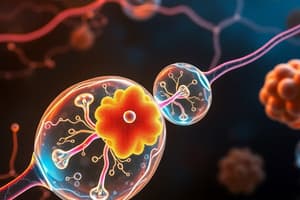Podcast
Questions and Answers
What is the net ATP gain from glycolysis?
What is the net ATP gain from glycolysis?
- 2 ATP (correct)
- 4 ATP
- 6 ATP
- 8 ATP
What is the byproduct of pyruvate oxidation in the Krebs cycle?
What is the byproduct of pyruvate oxidation in the Krebs cycle?
- Carbon dioxide
- Coenzyme A
- Citric acid (correct)
- Acetyl-CoA
How many ATP molecules are generated from one FADH2 molecule in the electron transport chain?
How many ATP molecules are generated from one FADH2 molecule in the electron transport chain?
- 2 ATP (correct)
- 4 ATP
- 1 ATP
- 3 ATP
What is the purpose of Coenzyme A in the Krebs cycle?
What is the purpose of Coenzyme A in the Krebs cycle?
How many NADH molecules are generated from one pyruvate molecule in the Krebs cycle?
How many NADH molecules are generated from one pyruvate molecule in the Krebs cycle?
What is the total ATP yield from the electron transport chain?
What is the total ATP yield from the electron transport chain?
What is the characteristic of glycolysis in terms of oxygen presence?
What is the characteristic of glycolysis in terms of oxygen presence?
The process of glycolysis is aerobic, meaning it requires oxygen.
The process of glycolysis is aerobic, meaning it requires oxygen.
Pyruvate molecules each have 4 carbons.
Pyruvate molecules each have 4 carbons.
The Krebs cycle produces 2 ATP molecules.
The Krebs cycle produces 2 ATP molecules.
Coenzyme A is a 3-carbon chain.
Coenzyme A is a 3-carbon chain.
One pyruvate molecule produces 2 NADH and 1 FADH2 in the Krebs cycle.
One pyruvate molecule produces 2 NADH and 1 FADH2 in the Krebs cycle.
The electron transport chain generates ATP through a process called ATPase.
The electron transport chain generates ATP through a process called ATPase.
The total ATP yield from all three processes of cellular respiration is 36 ATP.
The total ATP yield from all three processes of cellular respiration is 36 ATP.
Flashcards are hidden until you start studying
Study Notes
Cellular Respiration
- Cellular respiration is the process of converting glucose into ATP through three stages: Glycolysis, Krebs Cycle, and Electron Transport Chain.
Glycolysis
- Breaks down glucose into 2 pyruvate molecules, each with 3 carbon atoms
- Anaerobic process, meaning it does not require oxygen
- Requires 2 ATP to initiate the process
- Net gain of 2 ATP and 2 NADH molecules
Krebs Cycle
- Aerobic process, meaning it requires oxygen
- Pyruvate molecules are oxidized, releasing one carbon atom
- Coenzyme A (2-carbon chain) combines with the remaining pyruvate to form citric acid (6-carbon molecule)
- NAD+ and FAD pick up electrons from pyruvate, generating NADH and FADH2
- 1 pyruvate molecule yields 3 NADH and 1 FADH2 molecules
- Total yield: 6 NADH and 2 FADH2 molecules
Electron Transport Chain
- NADH and FADH2 from the Krebs cycle are used to generate ATP
- ATP synthase produces ATP from the energy released by the electron transport chain
- 1 NADH molecule generates 3 ATP molecules
- 1 FADH2 molecule generates 2 ATP molecules
- Total ATP yield: 34 ATP molecules
Total ATP Yield
- Glycolysis: 2 ATP
- Krebs Cycle: 2 ATP
- Electron Transport Chain: 34 ATP
- Total: 38 ATP molecules
Studying That Suits You
Use AI to generate personalized quizzes and flashcards to suit your learning preferences.




